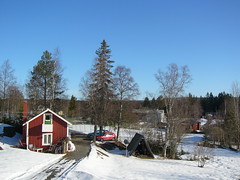Let's start with Bötsle.
If you want to know exactly where Bötsle is then click on the photo on the right to link to the original in Flickr. From there you can fly to Bötsle if you have Google Earth installed, via the first comment. Once you've seen Bötsle's general location (from a hight of 21 km!) you can zoom in. If I'd lived 200 meters south of where I do you could have seen my house on Google Earth but the high definition area around Härnösand stops just short of Bötsle!
I already had audacity and LAME installed because I've used sound in my work sometimes so there was no complication there. Figuring out how to load up a podcast to Switchpod was not the easiest task in the world so I went looking for another site and found the site that now hosts part two of my description - PodOmatic. This service seems to provide you with an audio blog. You can take a look at my page if you want to see how it looks. Naturally they would love you to sign up for a paid subscription but they do give you 500 MB of storage and 15 GB of download per month in the free version. My only criticism of PodOmatic is that there player is nowhere near as nice as the Switchpod one. (You can see them both further down this posting.)
The question of mp3 versus Vorbis Ogg is interesting. Mp3 has become a world standard and for normal users is both free and convenient, which makes it problematic to persuade people to use an alternative open source program. Using Vorbis Ogg requires the user to take extra steps, for example downloading an extra plug-in to enable Windows media player to play Ogg files. It isn't much extra effort or technical knowledge that is required but people are lazy! Why take the extra effort when you don't need to? Anyway, having written that I took the extra effort mentioned and went looking for Ogg music. I found some music I really liked and a recording studio with an interesting idea - sponsored music - but all the music I found was also offered as mp3! Can Ogg survive in an mp3 world? I guess time will tell.
What role does RSS play in podcasting. Well, first it does exactly the same as it does in the blog world and tells you when something new has come along. The additional factor is that the podcast can then be downloaded to your player and becomes portable. If I want to read your blog I have to have to use my computer but I can listen to your podcast as I train in the gym.
Originally I had part 1 of the podcast embedded here but as soon as the page loaded it started playing, which was irritating, especially when it was no longer the latest posting! So now there is a link to the podcast. Click on the link and then return to the picture above while you listen.
and when you've listened to that one you could try part 2...
Click here to get your own player.
By the way, read Barbara's comment - she makes the point that the switchpod player is more useful for the user/listener as you can move around in the podcast, something you can't do with the embedded PodOmatic player, although you can do that from my PodOmatic blog.
Subscribe to:
Post Comments (Atom)

3 comments:
Well done! Beautiful view you describe there and I liked the party part :-) It seems that you practiced quite a bit with the audio gadgets. From a users point of view I preferred swithpod as I can go back and fwd what I didn't manage with the other one. Bye for now.
Hi Keith,
Brilliant! Nice audio.
I think that the audio and the image together could be used just like that in language learning, e.g. in a small listening comprehension exercise.
E.g. in LeMill we could add the audio and the image and some questions, such as:
What is the small house for?
How many rooms are in it?
How long Keith has lived in there?
- Teemu
Just as a test I made this out of your audio and image:
http://lemill.net/content/english-listening
I hope it is ok for you.
Post a Comment